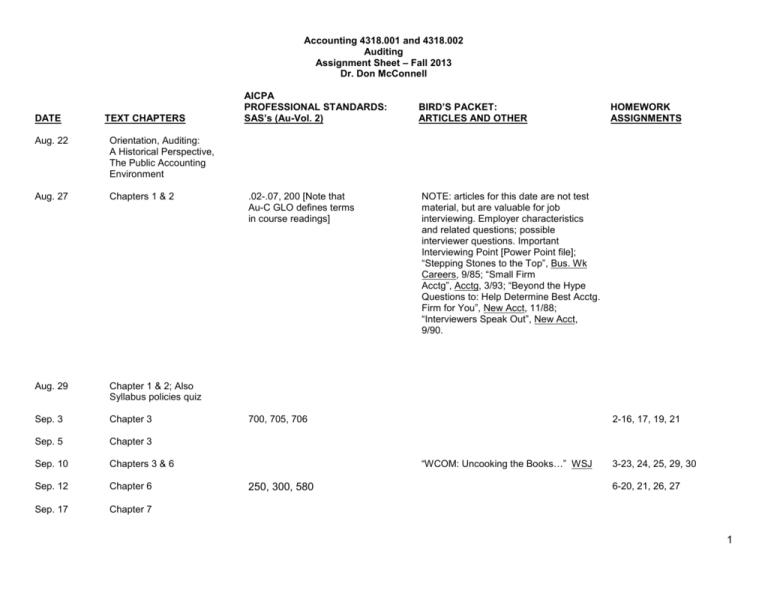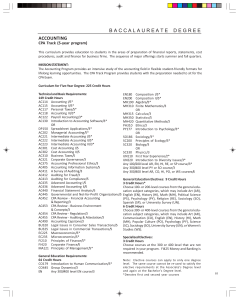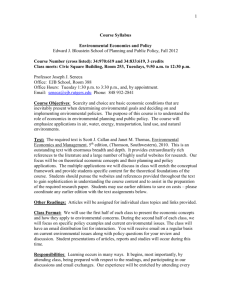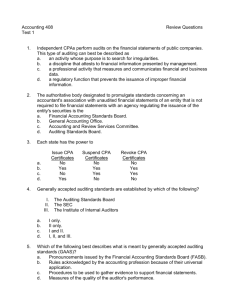Accounting 4318.001 and 4318.002 Auditing Assignment Sheet
advertisement

Accounting 4318.001 and 4318.002 Auditing Assignment Sheet – Fall 2013 Dr. Don McConnell DATE TEXT CHAPTERS Aug. 22 Orientation, Auditing: A Historical Perspective, The Public Accounting Environment Aug. 27 Chapters 1 & 2 Aug. 29 Chapter 1 & 2; Also Syllabus policies quiz Sep. 3 Chapter 3 Sep. 5 Chapter 3 Sep. 10 Chapters 3 & 6 Sep. 12 Chapter 6 Sep. 17 Chapter 7 AICPA PROFESSIONAL STANDARDS: SAS’s (Au-Vol. 2) .02-.07, 200 [Note that Au-C GLO defines terms in course readings] BIRD’S PACKET: ARTICLES AND OTHER NOTE: articles for this date are not test material, but are valuable for job interviewing. Employer characteristics and related questions; possible interviewer questions. Important Interviewing Point [Power Point file]; “Stepping Stones to the Top”, Bus. Wk Careers, 9/85; “Small Firm Acctg”, Acctg, 3/93; “Beyond the Hype Questions to: Help Determine Best Acctg. Firm for You”, New Acct, 11/88; “Interviewers Speak Out”, New Acct, 9/90. 700, 705, 706 2-16, 17, 19, 21 “WCOM: Uncooking the Books…” WSJ 250, 300, 580 HOMEWORK ASSIGNMENTS 3-23, 24, 25, 29, 30 6-20, 21, 26, 27 1 DATE TEXT CHAPTERS Sep. 19 Chapters 7 & 15; pp. 481-487 only Sep. 24 Chapters 7 & 8 Sep. 26 Chapters 8 & 9 Oct. 1 Chapter 9 Oct. 3 Chapter 9 Oct. 8 Chapters 10 & 13 Oct. 10 EXAM I: Through Ch. 6 only Oct. 15 Critique exam and Chapters 10 & 13 Oct. 17 Chapter 14 Oct. 22 Chapter 14 Oct. 24 Chapter 11 Oct. 29 Chapter 11 Oct. 30 LAST DAY TO DROP COURSE Oct. 31 Chapter 16 AICPA PROFESSIONAL STANDARDS: SAS’s (Au-Vol. 2) BIRD’S PACKET: ARTICLES AND OTHER HOMEWORK ASSIGNMENTS 230, 520, 260, 500 7-25, 26, 28 210, 550, 620, 510, 320, 450 “Practice Considerations in Accepting and Performing Re-Audits”, J of A, 1/02 8-25, 26, 27 9-23, 24(a) and (b), 25, 32, 35 315, 330, 265, 610 10-30, 31, 32, 37 13-22, 23, 24 “Implementing the New ASB Risk Assessment Audit Standards”, CPA Journal, 6/07 240 “Expanded Guidance for Auditor Fraud Detection Responsibilities”, CPA Journal, 6/03 14-21, 22, 23, 27 11-20, 21, 22 505 “Common Peer Review Deficiencies in the Application of Confirmation Procedures”, J of A, 6/98; “Better Evidence Gathering”, J of A, 4/08 2 DATE TEXT CHAPTERS AICPA CODIFICATION PROFESSIONAL STANDARDS: SAS’s (Au-Vol. 2) BIRD’S PACKET: ARTICLES AND OTHER HOMEWORK ASSIGNMENTS “Advance to Go: Collect $800,000”, Internal Auditor, 6/05 Nov. 5 Chapter 16 Nov. 7 EXAM II: Ch. 7-10, 13 and 14 Nov. 12 Critique exam and Chapters 16 & 20 16-20, 21, 22 20-17,18; 11-29 Nov. 14 Chapter 18 Optional book report due Nov. 19 Chapters 18 Nov. 26 Chapter 18 Nov. 28 Thanksgiving Holidays! Dec. 3 Chapter 23 18-12, 18, 19, 28 23-18, 19, 20 3 COURSE OBJECTIVES AND STUDENT LEARNING OUTCOMES: There are two major objectives in this course. The first of these is to prepare you to perform competently as an entry-level auditor in public or private accounting. For those not entering the auditing profession, this objective may be stated in terms of familiarizing you with the auditing function. The second objective is to prepare you for the uniform CPA exam. The course provides an introduction to auditing and the profession of accounting. Emphasis is placed upon generally accepted auditing standards and professional responsibilities, the auditor's decision making process in obtaining and evaluating sufficient competent evidential matter, and assurance reporting responsibilities. Students completing this course will have a : (1) basic knowledge of auditing procedures which would typically be performed by entry-level auditors in public accounting; (2) basic knowledge of typical fraud schemes (misstatements arising from fraudulent financial reporting and misstatements arising from misappropriation of assets) relevant to transaction cycles studied in the course; and (3) reasonable knowledge of the auditing standard setting process and related regulatory environment, e.g. the Securities and Exchange Commission and Public Company Accounting Oversight Board. COURSE PREREQUISITES: Accounting 3303 and 3312, or equivalent, are prerequisites for this course. FINAL EXAMINATION: Section 001 – Meets in COBA 149, Tuesday & Thursday at 5:30 p.m. – 6:50 p.m., Final on Tue.,12/10/2013, 5:30 p.m. – 8:00 p.m. Section 002 – Meets in COBA 348, Tuesday & Thursday at 9:30 a.m. – 10:50 a.m., Final: Tue.,12/12/2013, 8:00 a.m. – 10:30 a.m. COURSE GRADE: Pts. % Examinations (2), approximately 33% essay* Comprehensive Final Examination*(Roughly 70% of material since Exam II) 320 180 64.0 36.0 ____ 500 ____ 100 A -- 90% B -- 80% C -- 70% D -- 60% F – below 60% *Exams will contain some old CPA exam questions. You may optionally purchase a copy of Auditing & Systems Objective Questions at the bookstore for about $15.00. Also, a diskette version (Gleim Auditing EQE) can be obtained at the UTA bookstore or ordered at http://www.gleim.com, and is highly suggested because of the new CPA Exam format. This source is invaluable in learning "how" to answer exam questions. Appx A, text cross-reference index (in Objective Questions book and software) links questions to your text chapters. (Experience regrettably shows students who do not review old questions will score about a letter grade less than the class exam average). A considerable portion of what you need to learn from an auditing course can only be conveyed through my lectures. Much of this material is not "in the book," and is not amenable to testing on exams; however, it is important because I want to provide you with practical insights into the practice of public accounting. Consequently, attendance is important. For each two full weeks of unexcused class absences (3 absences) a student’s grade will be reduced by one letter grade. [Proof must be provided for excused absences.] Trends in examination scores will be considered in assigning grades to students who are “borderline” between A and B, B and C, etc. “Borderline” grade cases will also be considered in terms of the individual’s performance on the comprehensive final exam. Specifically, a student whose final exam score is less than the class average on the final should expect to receive a lower course grade. Also, “borderline grade” students who have not availed themselves of extra credit opportunities should expect to receive the lower grade. No student whose final exam grade is less than the class average on the comprehensive exam will receive an A in the course. 4 There will be no make up examinations. The final examination will carry a weight of 340 points in the event that you have missed a regular examination; the final examination is required for course credit. Trends in examination scores will be considered in course grade. An “A” grade will not be awarded unless all regular examinations are taken or where the final is being used as a make-up exam for a regular exam missed due to an excused absence. Grades of “X” (incomplete) will not be granted except in the most extenuating of circumstances. The optional book report, if turned in late, will be penalized 33% of total possible project points. Book reports submitted late will not be accepted after December 6, 2013. If you have received a grade for the book report in a previous semester, you will not have to redo the report. However, it is your responsibility to notify me, so a grade transfer can be made. I will be providing answers to you for most of the written assignments by e-mail attachments. If no answer has been provided for an assigned course problem, this means that we will cover the problem in class and you should be prepared to discuss it once we have covered that topic in class. Some exam questions will come from the assigned written assignments or variations of those assignments. IMPORTANT NOTE: Homework assignments are arranged differently in the international (paperback) version of the text book. I recommend that you not use the international version, which is typically available from internet book selling services. If you have a question about your course grade, you must contact me within two weeks after the first class day of the immediately following regular or summer semester. Due to storage limitations, I discard exams, projects, etc. after that time. To better understand classroom discussion, you should always read assigned course materials before my lectures. Pop quizzes may be given if it is my sense that many students are coming to class unprepared. If given, these quizzes will be for extra course credit, typically given at the beginning of class, and will cover the most basic issues from the assigned reading materials. If you are keeping up with the reading assignments, you should do well on any such quizzes. TEXT MATERIALS: REQUIRED: Auditing and Assurance Services: An Integrated Approach, 15th ed., Arens, Elder and Beasley. It is not advisable to buy the international version [available on the internet], as the end of chapter problems do not correspond with those in the domestic version. 2012 AICPA Professional Standards, vols. 1 - 3. AICPA SAS’s are referenced as Au sections in the codification. Au sections contain interpretations of the preceding Au sections and are coded to those sections. For example, Au 9265 contains staff interpretations of questions posed pertaining to Au 265. CPA exam candidates are encouraged, though not required, to read sections numbered 9000’s. Underscored Au section numbers are recent and, therefore, of extreme importance to those who will sit for the CPA exam within the next few years. The standards contained in the book above can also be accessed at no cost at: http://www.aicpa.org/research/standards/auditattest/pages/clarifiedsas.aspx; however, we will often reference the auditing standards in class, so you will need to be able to access them readily. The assigned Au sections will be found in the third column of the displayed pages, with the underlying SAS references in the first column. A packet of Scantron sheets, Form 882E (preferable) or Form 882 5 All items under "Articles and Other" are located in a course packet you need to purchase from Bird's Copies (208 S. East St.). Bird’s Copies will mail packet to you, if you wish. Call 817-459-1688, or email to www.birdscopies.com. Note: Bird's Copies currently closes about 7:00 p.m. NOTE: The above materials are also used in the second auditing course at the graduate level: Acct. 5318. OPTIONAL: The Auditor: An Instructional Novella, Loebbecke. This is an interesting, realistic short novel about an individual’s career experiences and ultimate promotion to partnership in a fictional West Coast public accounting firm. Students who choose to read this novel, and write a good typed book report can receive up to 15 additional grade points (3% of course grade). There is no required length; however, your report must summarize and analyze the entire novel. You will need to submit a paper copy and an electronic copy by email attachment. These will be analyzed with UTA software to seek out instances of possible plagiarism. [Note: Don’t wait beyond mid term to buy this book, as the Book Store often returns excess inventory to publishers before end of semester.] If you are planning to go into public accounting as an auditor, this is a must read, even if you do not write the book report. Auditing and Systems Objective Questions, or preferably Gleim Auditing EQE Software. (Extremely helpful for exam preparation!) Bring Arens text, AICPA Professional Standards Vol. 2, and Bird's Packets to every class meeting. OFFICE HOURS: Room 420 COBA, ph: (817) 272-3057, TTh 2:00 pm - 4:00 pm; Th 8:00 - ? [It is advisable to let me know beforehand when you want to come by for office hours in case a presently unscheduled meeting arises during the semester.] E-mail: McConnell@uta.edu Website: http://www2.uta.edu/accounting/mcconnell "No man ever reached to excellence in any one art or profession without having passed through the slow and painful process of study and preparation." Horace "It is attitude, not aptitude, which determines altitude." Author Unknown 6




